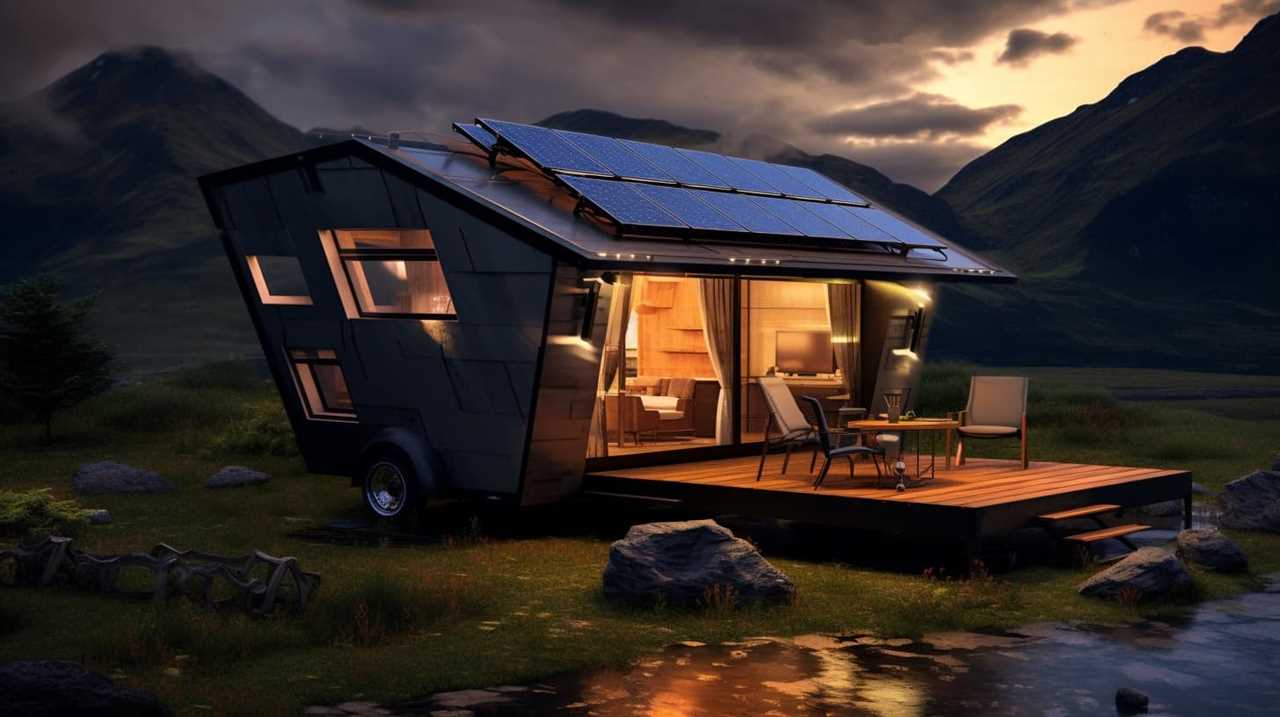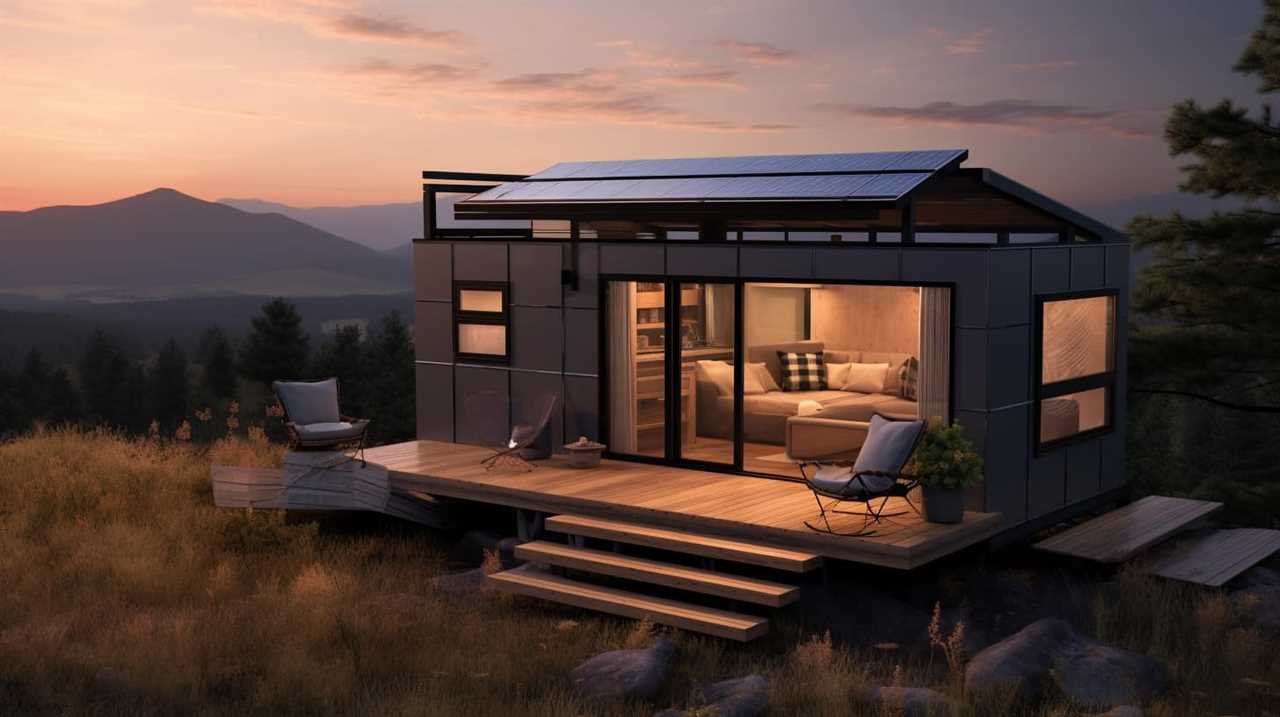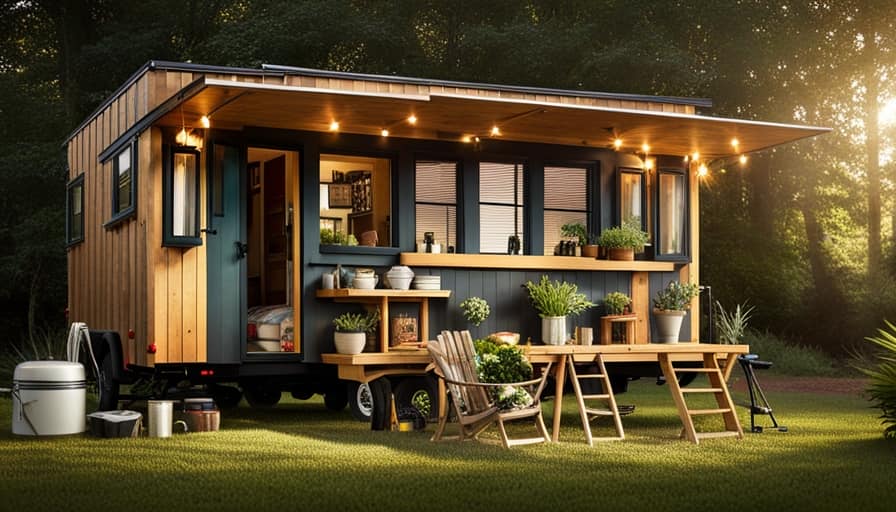Welcome to our stunning compilation of the top 10 must-see tiny house tours! Prepare yourself to discover a realm of tiny marvels that will truly amaze you.
From cozy cabin retreats to urban chic masterpieces, these tiny houses pack a punch when it comes to style, functionality, and charm. Join us as we embark on a journey to explore these extraordinary homes, each offering a unique and delightful experience.
Prepare to be amazed as we serve you the best of tiny house living!
Key Takeaways
- The article will showcase the top 10 miniature wonders in the world of tiny house tours, providing readers with diverse designs and styles to inspire their own tiny house dreams.
- Readers will have the opportunity to experience the charm and uniqueness of each tiny house, learning about the creative solutions that make these small spaces functional and visually stunning.
- The article will highlight the benefits and creativity of tiny house living, such as the peaceful and tranquil atmosphere of a rustic farmhouse getaway and the boundless creativity of tiny house owners in showcasing their personality and style.
- By uncovering these miniature wonders, readers will discover the endless possibilities of tiny house living, from cozy and rustic retreats to modern and stylish spaces, and even coastal and beach-inspired havens.
The Cozy Cabin Retreat
We can’t wait to take you on a tour of the cozy cabin retreat. Step inside and be enveloped by the warm embrace of rustic charm.

The cozy cabin decor exudes a sense of tranquility, with its earthy tones and natural textures. Adorned with vintage furniture and knickknacks, every corner tells a story of comfort and nostalgia.
The crackling fire in the stone fireplace invites you to curl up with a good book, while the soft glow of candlelight sets the perfect ambiance for relaxation.
This cabin retreat inspiration is a haven from the chaos of everyday life, a place where you can unwind and recharge your spirit.
A Quaint Cottage in the Woods
As we venture deeper into the enchanting woods, we stumble upon a quaint cottage that beckons us to explore its charming interior. This peaceful retreat is nestled amidst towering trees, creating a sense of serenity and tranquility. Let’s step inside and discover the wonders that await us:

-
Immerse yourself in nature:
The cottage boasts large windows that frame breathtaking views of the surrounding forest, allowing you to feel completely immersed in nature. A cozy reading nook by the window invites you to curl up with a good book and soak in the peaceful ambiance. -
Rustic charm meets modern comfort:
The interior of the cottage exudes rustic charm, with exposed wooden beams and a stone fireplace, creating an inviting and warm atmosphere. Despite its quaint appearance, the cottage is equipped with modern amenities such as a fully-equipped kitchen and a luxurious bathroom, ensuring a comfortable stay.
This quaint cottage in the woods offers a serene and idyllic getaway, perfect for those seeking a peaceful retreat from the hustle and bustle of everyday life.
Modern Minimalism: a Tiny House With Style
Let’s explore the sleek and stylish interior of a tiny house that showcases modern minimalism at its finest. This tiny house is a true testament to the idea that less is more. With its clean lines, neutral color palette, and smart use of space, it exudes stylish simplicity.

Inside, you’ll find a well-designed layout that maximizes every inch of the space. A three-column, four-row table showcases the key features of this modern minimalist tiny house:
| Features | Description |
|---|---|
| Open Concept | The open layout creates a sense of spaciousness |
| Minimalist Decor | Simple and streamlined furniture and decor |
| Efficient Storage | Clever storage solutions to keep things organized |
| Natural Light | Large windows allow plenty of natural light to fill the space |
Every detail in this tiny house has been carefully considered, from the sleek kitchen to the cozy sleeping loft. It’s the perfect example of how modern minimalism can create a stylish and functional living space, even in the smallest of homes.
The Ultimate Tiny Beach House
When it comes to the ultimate tiny beach house, we’re talking about unique coastal design, creative space utilization, and beachfront lifestyle inspiration.
Picture a charming cottage nestled right on the sandy shores, with a carefully curated interior that maximizes every inch.

From clever storage solutions to breathtaking ocean views, this tiny beach house is the epitome of coastal living in a compact space.
Unique Coastal Design
We’re excited to take you on a tour of the Ultimate Tiny Beach House, showcasing its unique coastal design. This coastal retreat has been beautifully designed with a nautical-inspired theme, bringing the beach vibes right to your doorstep.
Here are a few highlights of the Ultimate Tiny Beach House’s unique coastal design:
-
Seaside colors and materials: The interior is adorned with soothing shades of blue and white, reminiscent of the ocean waves. The use of natural materials like driftwood and seashells adds a touch of authenticity to the coastal theme.

-
Nautical accents: From anchor-shaped hooks to sailor’s knots, the tiny beach house is filled with charming nautical details. These accents create a sense of whimsy and add character to the space.
As we explore the unique coastal design of the Ultimate Tiny Beach House, let’s also delve into its creative space utilization, making the most out of every square inch.
Creative Space Utilization
In our tour of the Ultimate Tiny Beach House, we’ll explore the creative space utilization that maximizes every square inch of this miniature coastal retreat. This tiny house showcases ingenious space-saving solutions and innovative design that make it feel much larger than it actually is.
As soon as you step inside, you’ll notice the clever use of multifunctional furniture. The dining table doubles as a work desk, and the sofa converts into a guest bed. The kitchen is equipped with hidden storage compartments and collapsible countertops, making it incredibly efficient.

The bedroom loft is a cozy nook that maximizes vertical space. The stairs leading up to the loft also serve as additional storage, with each step doubling as a drawer. The bathroom features a compact yet luxurious shower stall and a toilet with a built-in bidet.
Beachfront Lifestyle Inspiration
Let’s dive into the beachfront lifestyle inspiration offered by the Ultimate Tiny Beach House, where sun, sand, and serenity become the perfect backdrop for a truly unique living experience.
-
Tiny House Decor Ideas:
-
Embrace the coastal theme with light and airy colors, such as shades of blue and white, to create a sense of tranquility.

-
Use natural materials like driftwood, seashells, and sisal rugs to bring the beach indoors and add texture to your space.
-
Beachfront Living Tips:
-
Maximize your outdoor area by creating a cozy patio or deck where you can relax and enjoy the ocean breeze.
-
Opt for multi-functional furniture that can be easily stored or transformed to make the most of limited space.

The Ultimate Tiny Beach House offers not only a charming coastal aesthetic but also practical solutions for beachfront living. With these tiny house decor ideas and beachfront living tips, you can create your own slice of paradise by the sea.
Tiny Living in the City: Urban Chic at Its Finest
We’ve discovered a hidden gem in the bustling city – a tiny apartment that exudes urban chic at its finest. This compact living space showcases the perfect blend of style and functionality, proving that you don’t need a large home to live comfortably in the city.
With its clever use of space-saving solutions, this apartment demonstrates that urban living can be both practical and trendy. The apartment features a stunning urban garden, where residents can grow their own herbs and vegetables, bringing a touch of nature into the concrete jungle.
The compact living solutions, such as multi-functional furniture and smart storage solutions, maximize the use of every inch of space, creating a cozy and efficient living environment.

This tiny apartment truly exemplifies urban chic living at its finest.
Eco-friendly and Sustainable: The Green Tiny House
We can explore the eco-friendly and sustainable features of the green tiny house. This tiny house is built using innovative green building techniques, making it a great example of environmentally conscious living.
Here are some key features that make this tiny house eco-friendly and sustainable:
-
Energy Efficiency:

-
Solar panels installed on the roof help generate clean, renewable energy.
-
High-quality insulation and energy-efficient windows minimize the need for heating and cooling.
-
Sustainable Materials:
-
Recycled and reclaimed materials are used throughout the construction, reducing waste and minimizing the environmental impact.

-
Non-toxic and eco-friendly paints and finishes are chosen to ensure a healthy living environment.
By incorporating these green building techniques and energy-efficient features, the green tiny house promotes sustainable living and reduces its carbon footprint.
Now, let’s move on to the next section and explore the benefits of a tiny house on wheels: nomadic living at its best.
A Tiny House on Wheels: Nomadic Living at Its Best
Let’s talk about the advantages of living in a tiny house on wheels.

One of the biggest benefits is the mobility it offers, allowing you to take your home wherever you want to go. Whether you’re craving a change of scenery or want to explore new places, a tiny house on wheels gives you the freedom to do so.
Additionally, downsizing to a smaller space means less maintenance and lower costs, giving you more time and resources to focus on the things that truly matter.
Mobility and Flexibility
We’re about to embark on a journey to explore the mobility and flexibility of a tiny house on wheels, experiencing nomadic living at its best. Living in a tiny house on wheels offers a unique sense of freedom and adventure. Here are some reasons why it’s worth considering:
-
Mobility and Flexibility

-
Allows you to travel and explore new places without leaving the comfort of your home.
-
Provides the flexibility to change your surroundings whenever you desire.
-
Innovative Space Saving Techniques
-
Cleverly designed furniture and storage solutions maximize every inch of space.

-
Multi-functional areas adapt to your needs, transforming from a living room to a bedroom effortlessly.
Living in a tiny house on wheels gives you the opportunity to embrace a minimalist lifestyle while enjoying the freedom to go wherever your heart desires.
Now, let’s delve into the advantages of downsizing and simplifying your life even further.
Advantages of Downsizing
But, there’s more to living in a tiny house on wheels than just the freedom to travel – there are also numerous advantages to downsizing and simplifying our lives.

By embracing a minimalist lifestyle and reducing our possessions, we can experience a multitude of benefits. First and foremost, downsizing allows us to achieve financial freedom. With a smaller space and fewer belongings, we can significantly reduce our expenses, including mortgage or rent payments, utilities, and maintenance costs. This newfound financial freedom allows us to save more, invest in experiences rather than material possessions, and pursue our passions.
Additionally, a minimalist lifestyle promotes a sense of clarity and focus by eliminating clutter and distractions. It can lead to less stress, improved mental well-being, and a greater appreciation for the things that truly matter in life. By embracing downsizing, we can create a more intentional and fulfilling existence.
Speaking of intentional living, let’s now explore the incredible features of a tiny house with a rooftop garden.
The Tiny House With a Rooftop Garden
The tiny house features an incredible rooftop garden that we absolutely love. Not only does it bring a touch of nature to this compact space, but it also has numerous benefits for the homeowners. Here are a couple of reasons why rooftop gardening is so amazing:

-
Rooftop Gardening Benefits:
-
Increases green space in urban areas, improving air quality and reducing the urban heat island effect.
-
Provides a sustainable source of fresh produce, promoting self-sufficiency and reducing food miles.
-
Innovative Space Saving Techniques:

-
By utilizing the rooftop, the tiny house maximizes its limited square footage, creating a functional and beautiful outdoor oasis.
-
The garden utilizes vertical planting methods, such as trellises and hanging baskets, to make the most of the available space.
With its rooftop garden, this tiny house showcases the perfect combination of functionality and beauty.
Now, let’s transition into the subsequent section about the ‘rustic charm: a tiny farmhouse getaway’.

Rustic Charm: A Tiny Farmhouse Getaway
Let’s explore the rustic charm of a tiny farmhouse getaway and discover its cozy and inviting features. Imagine escaping to a peaceful countryside retreat, surrounded by lush green fields and fresh air. This rustic farmhouse is the perfect place to unwind and reconnect with nature. As you step inside, you are greeted by warm wooden beams and a crackling fireplace, creating a cozy atmosphere. The farmhouse is thoughtfully designed to maximize space and functionality, with a compact kitchen and dining area perfect for preparing and enjoying meals together. The bedroom, adorned with soft linens and vintage decor, offers a tranquil space for a good night’s sleep. Outside, a charming porch invites you to relax and take in the picturesque views. It’s the perfect spot to enjoy a cup of coffee or simply unwind with a good book.
Let’s take a closer look at the features that make this rustic farmhouse getaway so special:
| Features | Description |
|---|---|
| 1. Exposed wooden beams | Creates a cozy and rustic ambiance |
| 2. Crackling fireplace | Provides warmth and adds to the rustic charm |
| 3. Compact kitchen and dining area | Efficient use of space for preparing and enjoying meals |
| 4. Tranquil bedroom | Soft linens and vintage decor create a peaceful retreat |
| 5. Charming porch | Invites relaxation and offers picturesque views |
This tiny farmhouse getaway is the perfect escape for those seeking a peaceful and rustic retreat in the countryside. Its cozy and inviting features will make you feel right at home, allowing you to disconnect from the hustle and bustle of everyday life and reconnect with nature.
A Tiny House With a Big Personality: Quirky and Creative Design
Sometimes, we stumble upon a tiny house that truly stands out with its quirky and creative design. These tiny homes aren’t just places to live, but they’re works of art that showcase the owner’s personality and style.

Here are some of the most unique and imaginative tiny houses we’ve come across:
-
The Mushroom House: With its mushroom-shaped roof and whimsical details, this tiny house is a true fairytale come to life.
-
The Treehouse on Wheels: This tiny house is built on a trailer and resembles a treehouse, complete with a wooden exterior and branches that extend from the roof.
-
Secret Storage Nooks: Cleverly hidden compartments and shelves are incorporated into the design, maximizing storage space without sacrificing style.

-
Lofted Bed with Stairs: Instead of a traditional ladder, this tiny house features stairs leading up to a cozy lofted bed, creating a unique and functional sleeping area.
These tiny houses prove that quirky architecture and innovative storage solutions can go hand in hand, creating homes that are both visually stunning and highly functional. Step inside and be inspired by the boundless creativity and ingenuity of these tiny house owners.
Frequently Asked Questions
What Is the Cost of Building a Tiny House?
When it comes to building a tiny house, cost analysis and budgeting are crucial. It’s important to consider factors such as materials, labor, and permits. By carefully planning, we can create a beautiful and affordable tiny home.
How Do Tiny House Owners Handle Zoning and Building Codes?
When it comes to zoning challenges and building code exemptions, tiny house owners navigate a complex landscape. We find creative solutions, like partnering with RV parks or building on wheels, to ensure compliance while enjoying the freedom of tiny living.

Can a Tiny House Be Used as a Full-Time Residence?
Yes, a tiny house can be used as a full-time residence. The tiny house lifestyle offers many advantages, such as affordability, minimalism, and sustainability. Living in a tiny house allows us to prioritize experiences over material possessions.
Are There Any Financing Options Available for Tiny House Purchases?
Financing options for tiny house purchases are available through various loan options. These options allow individuals to achieve their dream of owning a tiny house without breaking the bank.
How Do Tiny House Owners Manage Their Utilities and Waste Disposal?
Tiny house owners manage their utilities and waste disposal by adopting sustainable practices such as using solar panels for electricity, collecting rainwater for water supply, composting toilets for waste disposal. Off grid living promotes self-sufficiency and reduces environmental impact.
Conclusion
In conclusion, these top 10 must-see tiny house tours offer a glimpse into the world of miniature wonders.
From cozy cabins to rustic farmhouses, each tiny house has its own unique charm and personality.
As the saying goes, ‘Good things come in small packages,’ and these tiny houses certainly prove that.
So, why not embark on a journey to explore these incredible homes and be inspired by their creative designs?

I’m Theodore, and I love tiny houses. In fact, I’m the author of Tiny House 43, a book about tiny houses that are also tree houses. I think they’re magical places where imaginations can run wild and adventures are just waiting to happen.
While tree houses are often associated with childhood, they can be the perfect adult retreat. They offer a cozy space to relax and unwind, surrounded by nature. And since they’re typically built on stilts or raised platforms, they offer stunning views that traditional homes simply can’t match.
If you’re looking for a unique and romantic getaway, a tree house tiny house might just be the perfect option.










